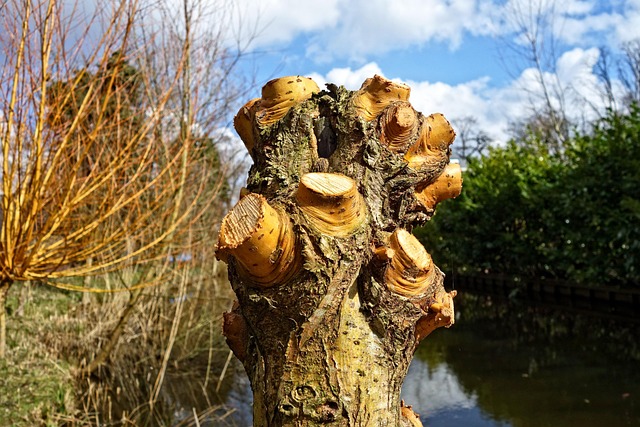Tree Pollarding. Is it Good Practice?
Who butchered that tree?
You’ve probably seen them—trees with their tops lopped off, thick knuckles of old cuts sprouting new shoots. Maybe you thought, “Who butchered that tree?” Or perhaps you admired the neat, compact shape. Pollarding splits opinions. Some call it vandalism. Others swear by it as essential tree care. Tree Pollarding. Is it good practice?
So, what’s the truth? Is pollarding a smart move for your trees, or an outdated hack job? Let’s dig into the real story—no jargon, no fluff, just straight-up facts from Scottish tree experts.

What Even Is Pollarding?
You’re walking through a historic estate in Edinburgh, and you spot an old willow with thick, gnarled stubs where branches should be. That’s pollarding—a pruning method where you chop back a tree’s upper branches to a set point, forcing it to regrow in a tight, controlled way.
It’s been around for centuries. It’s one of our 13 uses for trees. Farmers used it to produce firewood without killing trees. Councils do it today to stop street trees from tangling in power lines. But just because it’s old doesn’t always mean it’s good.
The Good: Why Some Trees (and People) Love It
1. Keeps Trees in Check
Got a monster sycamore looming over your garden? Pollarding can stop it from turning into a neighbourhood menace. Unlike topping (a brutal, tree-killing shortcut), proper pollarding keeps the tree alive—just smaller.
2. Can Make Trees Live Longer
Weird, right? Cutting bits off to help it grow. But some ancient pollarded trees in Scotland are hundreds of years old. By regularly trimming back growth, you reduce the risk of heavy branches splitting and causing decay.
3. Safety First
Storm Arwen taught us one thing: big branches + high winds = storm damage tree removal services. Pollarding reduces the risk of falling limbs, which is why some councils use it on street trees.
4. Looks Neat (When Done Right)
A well-pollarded lime tree in a formal garden? Gorgeous. A hacked-up oak in a park? Not so much. Skill matters.
The Bad: When Pollarding Goes Wrong
1. The “Butchered Tree” Effect
We’ve all seen them—trees that look like they’ve been attacked with a chainsaw. Bad pollarding leaves ugly stubs, weak regrowth, and stressed-out trees. Once it’s done poorly, it’s hard to fix.
2. Stress = Disease Magnet
Imagine losing half your limbs in one go. Trees feel that stress too. If pollarded at the wrong time (summer is a no-go) or on the wrong species (looking at you, conifers!), the tree can struggle to recover, inviting pests and rot.
3. Wildlife Loses Out
Birds nest in tall branches. Insects munch on leaves. Chop too much, and you’re kicking out your local ecosystem. Some experts argue that thinning (removing select branches) is better for nature than full pollarding.
4. It’s a Commitment
Pollarding isn’t a one-time job. Miss a cycle, and you’ll end up with a tangled mess of weak, fast-growing shoots. Most pros recommend re-trimming every 2–5 years.
So tree pollarding. Is it good practice?… Should You Do It?
✅ Yes, if…
✔ Your tree is a species that handles tree pollarding well (willows, limes, planes—yes; pines, oaks—no).
✔ You’ve got a pro doing it (seriously, don’t DIY this).
✔ You’re prepared for regular maintenance.
✔ The tree’s in a tight spot (near buildings, power lines).
❌ No, if…
✖ You just want to “tidy up” a healthy tree (try thinning instead).
✖ The tree’s young or already struggling.
✖ You can’t commit to future trims.
A Scottish Tree Surgeon’s Golden Rules
Our advice…
Timing is everything – Late winter/early spring, when the tree’s dormant.
Never remove more than 20% at once – Slow and steady wins the race.
Use sharp, clean tools – Ragged cuts = disease highway.
Know when to walk away – If a tree’s unhealthy, pollarding could finish it off.
Final Verdict: It’s Complicated
Pollarding isn’t evil. But it’s not a one-size-fits-all fix, either. When done right, it keeps trees safe, manageable, and even extends their life. Done wrong? It’s tree torture.
If you’re considering it, get a certified arborist’s opinion first. And if you see a butchered tree in your local park… maybe complain to the council.
What’s your take? Tree Pollarding. Is it good practice? Seen any great (or terrible) pollarding jobs in Scotland? Drop a comment—I’d love to hear your thoughts!
